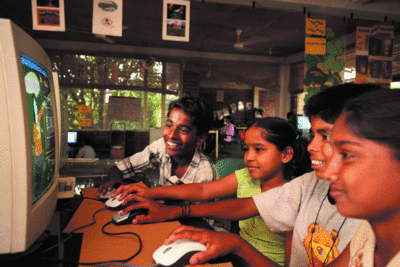Field NotesMultiple Mice, One PC
Kentaro Toyama
India today is a country of contrasts. On the one hand, it's an IT superpower with well-educated minds developing technology for the world's computing needs. On the other hand, 70 percent of the country still lives on less than $2 a day. These poles meet in the occasional computer classroom in poor government schools where one will find, at most, a handful of PCs. These computers are usually donated, as the schools themselves do not have budgets to afford them.
In these environments, students almost always outnumber computers. It's commonplace to find groups of up to 10 children crowding around a PC, and frequently the local bully takes over. Of course, the "personal" in personal computer means that PCs were designed for single-person use. We at Microsoft Research India wondered what we could do to provide computer access to more children.
The solution was surprisingly simple: MultiPointTM allows multiple USB mice to be plugged into a computer, so that each mouse corresponds to a different colored cursor on-screen (research.microsoft.com/users/udaip/multipoint.htm). Effectively, it creates a multi-person environment—just like a gaming console—so that educational software written for the multiple-mouse paradigm allows many children to interact with a PC simultaneously.
Young students immediately took to the paradigm, despite adult worries of total on-screen chaos. In rigorous studies with 7th grade students that compared five-person MultiPoint-PC configurations with single-student, single-PC configurations, researchers discovered several things. First, children would engage with the PC and with each other for much longer periods of time when they were each allowed access to a mouse, likely due to the additional fun factor. Second, it is important to design software apps that encourage collaboration rather than outright competition, or else some children—particularly boys—would regress to a "fast-twitch" competition with little educational value. Finally, if collaboration was built-in, students learned as much in a MultiPoint application as they did with a PC all to themselves, at least for simple vocabulary retention tasks. More information on the research is available on the previously provided MultiPoint link.

Purchased in bulk, mice cost just a few dollars each, which means that by providing MultiPoint educational applications to schools, the per-child cost of computing can be lowered significantly. For example, a $500 PC shared by five students with $5 mice comes to $105 per child—and anything that lowers the per-student cost is welcome to those who budget for education.
The Unlimited Potential (microsoft.com/unlimitedpotential) and Education (microsoft.com/education) groups at Microsoft recognized the value of MultiPoint for resource-strapped schools. To facilitate rapid and widespread adoption, they released a software development kit that allows educational content developers to apply this multiple-mouse paradigm in their C# applications easily. The SDK can be downloaded and used free of charge, and any Windows®-based computer can run MultiPoint applications (microsoft.com/downloads).
As one of the programs under the Unlimited Potential banner, the goal of the MultiPoint SDK is to extend the value of the PC to as many students as possible, and to do this, we need your help. Should you try your hand at an educational application with MultiPoint, please let us know. We will feature links to the best submissions on MultiPoint Web sites.
As for what's next, Microsoft Research India and the Terminal Services product team are considering another way to share a PC: Split Screen, where two people, two keyboards, and two mice share a PC and a monitor. The latter is split down the center so a separate session of the operating system can run on each side.
Kentaro Toyama is the Assistant Managing Director of Microsoft Research India (research.microsoft.com/india) and Principal Researcher of the Technology for Emerging Markets group (research.microsoft.com/research/tem), which develops technologies for economically poor communities worldwide.
© 2008 Microsoft Corporation and CMP Media, LLC. All rights reserved; reproduction in part or in whole without permission is prohibited.